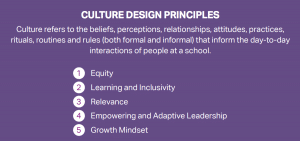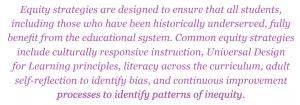5 Quality Design Principles for Culture
CompetencyWorks Blog
This is the seventh post in the blog series on the report, Quality and Equity by Design: Charting the Course for the Next Phase of Competency-Based Education.
Culture refers to the beliefs, perceptions, relationships, attitudes, practices, rituals, routines and rules (both formal and informal) that inform the day-to-day interactions of people at a school. In the previous blog in this series, we introduced 16 Quality Design Principles as a common reference point for dialogue about what makes a competency-based system high quality. The 16 Quality Design Principles are organized into three categories: Culture, Structure, and Teaching and Learning. In this blog, we explore the 5 Quality Design Principles related to Culture.

5 Culture Design Principles to Ensure High-Quality Competency-Based Systems
A school’s culture is the daily manifestation of its core beliefs; adults’ beliefs about themselves and their students; students’ beliefs about themselves and the adults around them; and beliefs about the outcomes that a school seeks to make possible with and for students. The school culture can be found in the relationships, the formal and informal routines and rituals, and in what gets attention and what doesn’t. School and district leadership, whether intentionally or not, influence school culture. Thus, the leadership and management strategies used will reinforce or undermine school culture.
 1. COMMIT TO EQUITY
1. COMMIT TO EQUITY
Equity is grounded in the belief that fairness means that each person receives what they need to succeed, rather than the same as everyone else. Thus, schools with an equity culture must provide teachers with the opportunity to get to know their students and the flexibility to respond to them. An equity culture is grounded in building strong trusting relationships between individuals that can support dialogue, reflection and learning. Schools that are building upon a culture of equity include in their principles of teaching a set of explicit strategies to embed cultural responsiveness and principles of Universal Design for Learning. Similarly, they turn to structures and processes such as continuous improvement to root out bias and institutional practices that contribute to inequity. We simply can not reach mastery for all students without addressing inequity.

 2. NURTURE A CULTURE OF LEARNING AND INCLUSIVITY
2. NURTURE A CULTURE OF LEARNING AND INCLUSIVITY
A culture of learning and inclusivity fosters learning for both students and adults. Building a strong culture of learning and inclusivity acknowledges that students must feel physically and emotionally safe in order to be ready to learn. Safety and trust are also prerequisites to risk-taking, which is in turn critical to productive struggle. Adults must experience this sense of safety themselves in order to foster this for students.
A culture of learning requires a shift from thinking about learning as a sequential process with an end point. Instead, everyone is learning and receives the instructional support they need for mastery of the skills and concepts. Furthermore, a culture of learning seeks to help students become self-aware, effective learners so that they are empowered as learners throughout their lives.
A culture of inclusivity reinforces that all students have a place within a learning community. This sense of belonging is reinforced through the rituals and routines in a school as well as the equity practices. One of the most powerful features of competency-based schools is the understanding that everyone is a learner and eliminating the trap of defining oneself as “a good student” or “school is not for me.” Instead, students understand where they are along a continuum of learning and feel that teachers care because they are helping them to learn and grow.
 3. BUILD CONNECTIONS THAT INCREASE RELEVANCE
3. BUILD CONNECTIONS THAT INCREASE RELEVANCE
Quality requires intentionality, and intentionality requires that schools be clear about their mission and design around it. The purpose of education must be rooted in the lives of students and their families. As discussed earlier, the purpose of public K-12 education is to prepare students for college, career and life. Districts and schools can shape what this means in terms of specific skills, knowledge and traits. High-quality districts and schools think about what skills are needed for success beyond high school. Fulfilling this purpose necessitates an understanding of students’ vision for their lives. An effective culture creates regular opportunities for students and adults alike to make connections to their current and future lives within the learning process.
 4. CULTIVATE EMPOWERING AND ADAPTIVE LEADERSHIP
4. CULTIVATE EMPOWERING AND ADAPTIVE LEADERSHIP
A culture of adaptive leadership that empowers others within a school is needed to create the flexibility and responsiveness to personalize learning and respond to students’ changing needs. Leadership is adaptive — it responds to real-time circumstances of students and anticipates leadership from educators and students alike. When students are building agency and having voice in their education, it is important that teachers are equally empowered to engage and co-construct learning experiences.
This view of leadership is distinct from most traditional schools that generally draw upon a bureaucratic culture and top-down management strategies. A culture of empowering and adaptive leadership provides autonomy to those closest to students, enabling them to respond to students’ needs in real time. A competency-based school without this autonomy will be hard pressed to reliably meet students where they are.
 5. FOSTER THE DEVELOPMENT OF GROWTH MINDSET
5. FOSTER THE DEVELOPMENT OF GROWTH MINDSET
Undergirding the traditional system is a belief that there are winners and losers based on the idea that intelligence is fixed and there is little to do about it. The result is some students are well served receiving the education that prepares them for college and others are underserved. By contrast, a growth mindset culture believes that intelligence is malleable. It anticipates failure and systematically exploits it to advance learning.22 The importance of the growth mindset applies to students and adults alike. In Dr. Richard Elmore’s concept of “reciprocal accountability,” implementation of high-quality competency-based systems must attend to the pedagogy of adult learning and capacity building as carefully as they attend to the pedagogy of students. Creating environments where students engage in productive struggle and risk-taking requires educators to also have opportunity for risk-taking so that they build the capacity to foster this in effective ways for students.
The next blog in this series will explore the 7 Quality Design Principles relating to Structure, which refers to the arrangement of, and relationship between, the elements of a system. It is the policies, processes and practices that influence decision making and the daily operations of a school. Follow this blog series for more articles charting the course for the next phase of competency-based education, or download the full report:
- Quality and Equity by Design
- Readiness for College, Career and Life: The Purpose of K-12 Public Education Today
- Why A Competency-Based System Is Needed: 10 Ways the Traditional System Contributes to Inequity
- How Competency-Based Education Differs from the Traditional System of Education
- Competency-Based Education and Personalized Learning Go Hand-In-Hand
- Building Shared Understanding of Quality through Design Principles